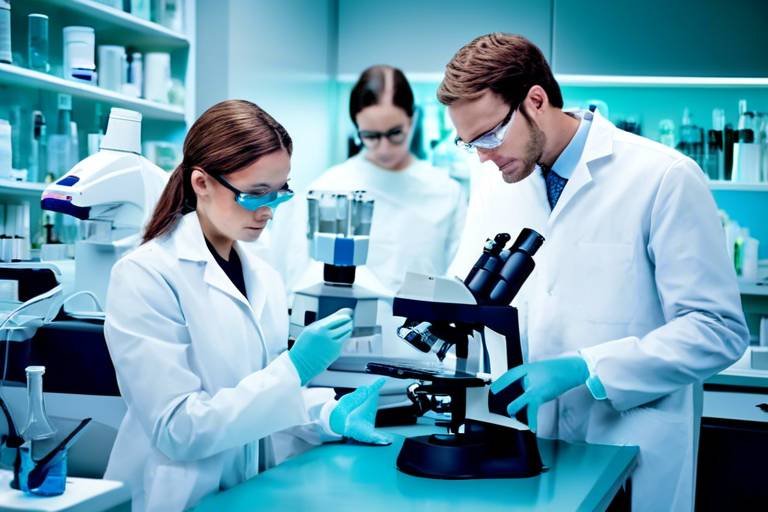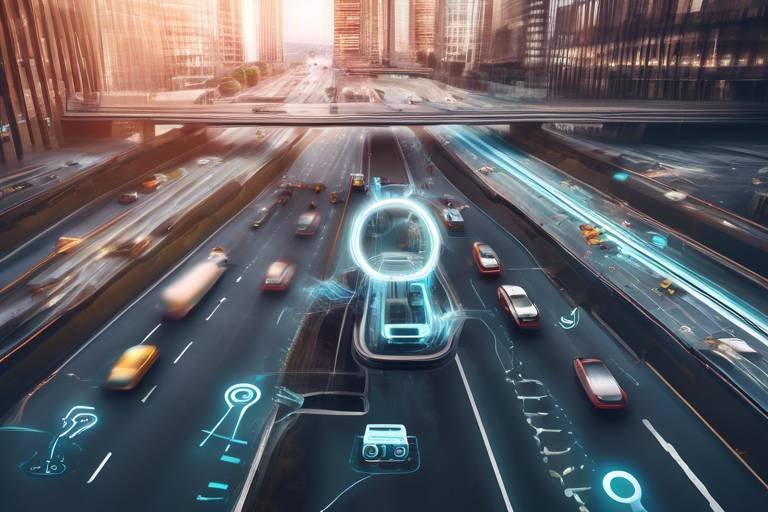The Intersection of Science and Technology in Agriculture
In today's fast-paced world, the intersection of science and technology is reshaping agriculture in ways we never thought possible. Imagine walking through a field where every plant is monitored in real-time, where data drives decisions, and where sustainability is not just a goal but a reality. This transformation is not just a dream; it’s happening right now! With the global population expected to reach nearly 10 billion by 2050, the pressure on agricultural systems is immense. Farmers are now turning to advanced technologies to meet this demand while also addressing environmental concerns. The integration of cutting-edge solutions is paving the way for a more efficient, productive, and sustainable agricultural landscape.
One of the most exciting developments in this arena is precision agriculture. This approach uses technology to monitor and manage field variability in crops, allowing farmers to optimize inputs like water and fertilizers. By utilizing sensors, GPS, and data analytics, farmers can apply resources more efficiently, leading to enhanced productivity and minimal environmental impact. It's like having a personal assistant for every acre of land, ensuring that each plant receives exactly what it needs to thrive.
Moreover, biotechnology is playing a crucial role in crop improvement. With the advent of genetically modified organisms (GMOs), farmers can cultivate crops that are resistant to pests and diseases. This innovation not only boosts yields but also reduces reliance on chemical pesticides. Think of it as giving plants a superhero cape that protects them from harm while contributing to global food security.
Data analytics is another game-changer in farming. By leveraging data collected from various sources, farmers can make informed decisions that optimize their operations. Analyzing trends and patterns allows them to identify inefficiencies and opportunities for improvement. It's akin to having a crystal ball that reveals the best path forward, ultimately enhancing both efficiency and profitability.
Drones are also making waves in the agricultural sector. These flying marvels provide aerial imagery and real-time data on crop health, enabling precise monitoring and targeted interventions. Imagine soaring above your fields, armed with a bird's-eye view that highlights areas needing attention. This technology enhances overall farm management, allowing farmers to address issues before they escalate.
Furthermore, automation and robotics are streamlining agricultural processes from planting to harvesting. By reducing labor costs and increasing efficiency, these technologies allow farmers to focus on strategic decision-making and innovation. It's like having a team of tireless workers who can handle the heavy lifting, leaving the farmers to think creatively about their next big move.
As we delve deeper into sustainable farming practices, the integration of science and technology emerges as a key player. Techniques such as crop rotation, organic farming, and conservation tillage not only enhance soil health and biodiversity but also ensure long-term agricultural productivity. It’s a win-win situation where farmers can cultivate their land while caring for the planet.
Climate-smart agriculture is another essential aspect of this transformation. By incorporating practices that increase resilience to climate change, farmers can adapt to shifting weather patterns and secure food supplies in the face of environmental challenges. It’s like building a fortress around their farms, ensuring they can withstand whatever Mother Nature throws their way.
Looking ahead, the future of agri-tech is brimming with promise. Emerging technologies like artificial intelligence and blockchain are poised to further revolutionize the industry. These advancements will enhance transparency, efficiency, and sustainability in global food systems, making agriculture smarter and more interconnected than ever before. Just imagine a world where every transaction is recorded transparently, and every decision is backed by data-driven insights.
- What is precision agriculture? Precision agriculture is a farming management concept that uses technology to monitor and manage field variability in crops, optimizing inputs like water and fertilizers.
- How does biotechnology improve crops? Biotechnology allows for the development of genetically modified organisms (GMOs) that are resistant to pests and diseases, improving yields and reducing pesticide use.
- What role does data analytics play in farming? Data analytics helps farmers make informed decisions by analyzing data collected from various sources, optimizing operations for better efficiency and profitability.
- How are drones used in agriculture? Drones provide aerial imagery and real-time data on crop health, allowing for precise monitoring and targeted interventions to enhance farm management.
- What are climate-smart agricultural practices? Climate-smart practices are strategies that increase resilience to climate change, helping farmers adapt to changing weather patterns and maintain food security.

Precision Agriculture
is like giving farmers a high-tech toolbox to tackle the age-old challenges of farming. Imagine being able to see every inch of your field, understanding which areas are thriving and which are struggling, all thanks to technology! This approach uses a variety of tools, including GPS technology, remote sensing, and data analytics, to monitor and manage field variability. By optimizing inputs such as water, fertilizers, and pesticides, farmers can significantly enhance their productivity while also being kind to the planet.
Think of it this way: if traditional farming is akin to using a shotgun to hit a target, precision agriculture is like using a laser sight. It allows farmers to apply resources more accurately, reducing waste and environmental impact. For instance, instead of spreading fertilizers uniformly across a field, farmers can now apply them only where they are needed. This not only saves money but also minimizes the risk of runoff, which can pollute nearby water sources.
The benefits of precision agriculture extend beyond just increased yields. It also promotes sustainability in several ways:
- Water Conservation: By using soil moisture sensors, farmers can monitor when and where to irrigate, ensuring that crops receive just the right amount of water.
- Reduced Chemical Use: Targeted application of fertilizers and pesticides means less chemical runoff and a healthier ecosystem.
- Improved Soil Health: Precision techniques encourage practices like cover cropping and reduced tillage, which enhance soil structure and fertility.
Moreover, precision agriculture is not just about technology; it’s about data-driven decision-making. Farmers can collect vast amounts of data from their fields and analyze it to identify patterns and trends. This information is invaluable for planning crop rotations, managing pests, and even predicting market trends. With the right tools, farmers can make informed decisions that lead to better outcomes for their crops and their bottom line.
As we look to the future, the integration of artificial intelligence and machine learning into precision agriculture is set to revolutionize how we grow food. Imagine algorithms that can predict the best planting times or the ideal crop varieties for specific conditions. This is not science fiction; it’s happening now, and it’s paving the way for a more efficient and sustainable agricultural landscape.
In summary, precision agriculture represents a significant leap forward in farming practices. By harnessing the power of technology and data, farmers can improve their yields, conserve resources, and protect the environment. It’s a win-win situation that promises to reshape the future of agriculture for generations to come.

Biotechnology in Crop Improvement
Biotechnology is a game changer in the world of agriculture, acting like a superhero cape for crops that need a little extra help. Imagine a farmer standing in a field, looking at rows of crops that are not just surviving, but thriving, thanks to the magic of science. This is the power of biotechnology, particularly through the development of genetically modified organisms (GMOs). These crops have been engineered to be resistant to pests and diseases, which means farmers can grow more food with less reliance on chemical pesticides. It’s like giving crops a shield against the villains of the agricultural world!
One of the most exciting aspects of biotechnology is its ability to enhance food security. With the global population projected to reach nearly 10 billion by 2050, the demand for food is skyrocketing. Biotechnology helps bridge this gap by improving crop yields. For instance, drought-resistant crops can be engineered to survive in regions where water is scarce, ensuring that farmers can still produce food even in challenging conditions. This is not just about increasing numbers; it’s about ensuring that every person has access to safe and nutritious food.
Additionally, biotechnology can contribute to environmental sustainability. By creating crops that require fewer inputs, such as water and fertilizers, we can reduce the environmental footprint of farming. For example, crops that are engineered to utilize nutrients more efficiently can lead to less runoff into nearby waterways, protecting ecosystems and promoting biodiversity. It’s like giving Mother Nature a helping hand while also feeding the world!
However, as with any technology, there are concerns and debates surrounding the use of GMOs. Some people worry about potential health risks or the impact on biodiversity. This is where education and transparency come into play. Farmers and consumers alike need to be informed about the benefits and risks associated with biotechnology. Open discussions can help demystify the technology and foster trust among consumers.
In conclusion, biotechnology in crop improvement is not just a trend; it’s a vital part of our agricultural future. By harnessing the power of science, we can create resilient crops that not only meet the growing food demands but also protect our environment. As we continue to innovate and explore the possibilities, the future looks bright for farmers and consumers alike.
- What are GMOs? Genetically Modified Organisms (GMOs) are plants or animals whose DNA has been altered using biotechnology to exhibit traits that are not naturally theirs.
- Are GMOs safe to eat? Extensive research has shown that GMOs currently on the market are safe to eat. Regulatory agencies around the world have conducted numerous studies to ensure their safety.
- How does biotechnology contribute to sustainability? Biotechnology can create crops that require fewer resources, such as water and fertilizers, thereby reducing the environmental impact of farming.
- Can biotechnology help with climate change? Yes, biotechnology can develop crops that are more resilient to climate change, such as drought-resistant varieties, helping ensure food security in changing climates.

Data Analytics in Farming
Imagine walking through a vast field of crops, each plant thriving under the sun, while you hold a device in your hand that tells you exactly how much water, fertilizer, and sunlight each crop needs. This is not just a dream; it’s the reality brought to life by . In today’s agricultural landscape, data analytics is revolutionizing how farmers operate, enabling them to make informed decisions that enhance productivity and sustainability.
At its core, data analytics involves collecting and analyzing information from various sources to uncover trends and patterns that can significantly impact farming practices. For instance, farmers can gather data from satellite imagery, soil sensors, and weather forecasts to create a comprehensive picture of their fields. This data-driven approach allows them to optimize their operations in ways that were once unimaginable.
One of the most profound benefits of data analytics is its ability to improve resource management. By analyzing data on soil moisture levels, farmers can determine the precise amount of water needed for irrigation, thus conserving water and reducing costs. Similarly, data on nutrient levels in the soil can guide farmers in applying fertilizers only where and when they are needed, minimizing waste and environmental impact. This precision not only boosts crop yields but also promotes a more sustainable approach to farming.
Moreover, data analytics can help farmers anticipate and mitigate potential risks. For example, by analyzing historical weather data and current climate trends, farmers can predict adverse weather conditions that may affect their crops. This foresight allows them to take proactive measures, such as adjusting planting schedules or implementing protective strategies, ultimately safeguarding their harvests.
To illustrate the impact of data analytics on farming, consider the following table:
| Data Source | Benefit | Example |
|---|---|---|
| Soil Sensors | Optimize irrigation and fertilization | Automated irrigation systems |
| Weather Forecasts | Plan for adverse weather events | Adjusting planting schedules |
| Satellite Imagery | Monitor crop health | Identifying pest infestations |
Additionally, the integration of data analytics with machine learning is paving the way for even more sophisticated farming techniques. By leveraging algorithms that learn from past data, farmers can refine their strategies over time, leading to continuous improvement in yield and efficiency. This blend of technology and agriculture is akin to having a personal coach for your crops—constantly analyzing performance and suggesting ways to enhance growth.
However, it’s essential to note that while data analytics offers incredible opportunities, it also presents challenges. Farmers must invest in technology and training to effectively harness these tools. Moreover, data privacy and security are critical concerns that need to be addressed as the agricultural sector becomes increasingly data-driven.
In conclusion, data analytics is not just a trend; it’s a transformative force in farming. By embracing this technology, farmers can unlock new levels of efficiency and sustainability, ensuring that they not only meet the demands of today but also prepare for the challenges of tomorrow. As we continue to innovate and integrate advanced technologies into agriculture, the potential for growth and improvement is limitless.
- What is data analytics in farming? Data analytics in farming refers to the use of data collection and analysis tools to improve agricultural practices, enhance productivity, and promote sustainability.
- How can data analytics help farmers? It helps farmers optimize resource management, predict weather impacts, and monitor crop health, leading to better decision-making and increased yields.
- What technologies are used in data analytics? Technologies such as soil sensors, satellite imagery, and machine learning algorithms are commonly used in agricultural data analytics.

Drone Technology in Agriculture
In recent years, drone technology has emerged as a game changer in the agricultural sector, providing farmers with innovative tools to monitor their crops like never before. Imagine having a bird's-eye view of your entire farm, enabling you to spot issues that would otherwise go unnoticed from the ground. Drones equipped with high-resolution cameras and sensors can capture detailed images of crop health, soil conditions, and even irrigation patterns. This level of insight is invaluable for making informed decisions that can significantly impact yields.
One of the most exciting aspects of using drones in agriculture is their ability to perform precision agriculture. This means that instead of treating an entire field uniformly, farmers can identify specific areas that require attention. For instance, using multispectral imaging, drones can detect variations in plant health, allowing farmers to apply fertilizers or pesticides only where needed. This not only saves money but also minimizes the environmental impact of chemical use.
Moreover, drones can assist in crop scouting, which is the process of inspecting fields to identify pests, diseases, or nutrient deficiencies. With a drone, farmers can cover large areas quickly and efficiently, reducing the time and labor involved in traditional scouting methods. This capability is particularly crucial during critical growth stages when timely interventions can make all the difference in yield outcomes.
Let’s break down some of the key benefits of utilizing drone technology in agriculture:
- Real-Time Data Collection: Drones can provide instantaneous feedback on crop health, allowing for quick decision-making.
- Cost Efficiency: By reducing the amount of pesticides and fertilizers used, drones help lower overall farming costs.
- Enhanced Monitoring: Regular aerial surveys can help track the growth of crops over time, providing insights that ground-based methods might miss.
- Improved Resource Management: Drones can help optimize water usage by identifying areas that require irrigation.
As we look to the future, the integration of drone technology into everyday farming practices is expected to grow. Farmers are increasingly adopting these technologies not only to boost productivity but also to ensure sustainability in their operations. In fact, a recent study showed that farms using drone technology reported an average increase in yield of up to 15%. This is a testament to how technology can enhance traditional farming methods, leading to a more efficient and sustainable agricultural landscape.
In conclusion, the rise of drone technology in agriculture is not just a trend; it's a revolution that is reshaping the way we think about farming. As drones become more accessible and affordable, their potential to improve agricultural practices will only continue to expand, paving the way for a more sustainable and productive future.
Q: How do drones improve crop monitoring?
A: Drones provide high-resolution aerial imagery that allows farmers to monitor crop health, identify pests, and assess irrigation needs more efficiently than traditional methods.
Q: Are drones expensive to operate in agriculture?
A: While there is an initial investment in drone technology, the long-term savings from reduced pesticide and fertilizer use, as well as increased yields, often outweigh the costs.
Q: Can drones be used for purposes other than monitoring?
A: Yes, drones can also be used for tasks like planting seeds, spraying pesticides, and even mapping fields for better planning.

Automation and Robotics
In the ever-evolving world of agriculture, are leading the charge towards a more efficient and productive future. Imagine a farm where machines handle the repetitive and labor-intensive tasks, allowing farmers to focus on strategic decision-making and innovation. This isn't just a dream; it's becoming a reality thanks to advancements in technology.
Automation in agriculture encompasses a wide range of technologies, from automated tractors to robotic harvesters. These machines are designed to perform specific tasks with precision and speed, significantly reducing the amount of time and labor required. For instance, automated tractors can plow, sow, and fertilize fields with minimal human intervention. This not only saves time but also ensures that the job is done with remarkable accuracy.
Robotics, on the other hand, takes automation a step further. Robots are now being developed to handle delicate tasks such as picking fruits and vegetables. These machines are equipped with advanced sensors and artificial intelligence, allowing them to assess the ripeness of produce and harvest it without causing any damage. This is particularly important in a market where quality is paramount, and consumers demand perfection.
One of the most exciting aspects of automation and robotics in agriculture is their ability to collect and analyze data. Many modern farming machines come equipped with sensors that monitor soil conditions, crop health, and weather patterns. This data can be invaluable for farmers, enabling them to make informed decisions that lead to better crop yields and reduced waste. For example, by analyzing soil moisture levels, farmers can optimize irrigation schedules, ensuring that crops receive just the right amount of water.
Furthermore, the integration of automation and robotics can lead to significant cost savings. By reducing labor costs and increasing efficiency, farmers can improve their bottom line. A study conducted by the Food and Agriculture Organization (FAO) revealed that farms utilizing automation technologies saw a 20-30% increase in productivity compared to traditional methods. This is a game-changer in an industry where margins can be razor-thin.
However, the transition to automated systems is not without its challenges. Initial investment costs for robotic systems can be high, and there is a learning curve associated with operating new technologies. Moreover, there are concerns about job displacement in rural communities. Yet, many experts believe that automation will create new job opportunities in tech support, machine maintenance, and data analysis, thus transforming the workforce rather than eliminating it.
In conclusion, the rise of automation and robotics in agriculture is transforming the industry. With the potential to increase efficiency, reduce labor costs, and improve crop yields, these technologies are paving the way for a more sustainable and productive future. As we embrace these innovations, it’s essential to strike a balance between technology and human labor, ensuring that the agricultural sector remains vibrant and resilient.
- What are the benefits of automation in agriculture? Automation helps reduce labor costs, increases efficiency, and improves crop yields.
- How do robots help in farming? Robots can perform delicate tasks such as harvesting and monitoring crops, ensuring quality and precision.
- Are there any downsides to using automation in agriculture? Initial costs can be high, and there may be concerns about job displacement.
- Will automation create new job opportunities? Yes, as new technologies emerge, they will create demand for skilled workers in tech support and maintenance.

Sustainable Farming Practices
Sustainable farming practices are not just a trend; they are a necessity in today’s world where environmental concerns are at the forefront. Imagine walking through a lush green field, the air filled with the scent of rich soil and blooming crops, knowing that this beauty is maintained through methods that protect our planet. Sustainable agriculture is all about balance—finding ways to produce food while ensuring that the ecosystem remains healthy and vibrant for future generations.
One of the key principles of sustainable farming is crop rotation. This technique involves alternating the types of crops grown in a particular area from season to season. It helps in maintaining soil fertility, reducing soil erosion, and controlling pests naturally. Picture a farmer rotating corn with soybeans; the soybeans fix nitrogen in the soil, replenishing nutrients that the corn depletes. This not only enhances productivity but also minimizes the need for chemical fertilizers, which can harm the environment.
Another essential practice is organic farming. Farmers who adopt organic methods avoid synthetic pesticides and fertilizers, opting instead for natural alternatives. This approach not only yields healthier crops but also promotes biodiversity in the ecosystem. By supporting organic practices, consumers can enjoy fresh produce while contributing to the health of the planet. It's like choosing to walk instead of drive—a small change that can lead to significant benefits.
Additionally, conservation tillage is a technique that has gained traction among sustainable farmers. This method minimizes soil disturbance, allowing for better moisture retention and reduced erosion. When farmers leave crop residues on the field after harvest, they create a protective layer that nurtures the soil and enhances its fertility. It’s akin to wrapping a gift carefully to ensure it stays intact; the soil is protected from harsh weather and erosion, leading to better yields in the long run.
Furthermore, sustainable farming practices often incorporate integrated pest management (IPM). This strategy combines biological, cultural, and mechanical controls to manage pest populations effectively. Instead of reaching for harmful chemicals at the first sign of trouble, farmers using IPM assess their fields and implement natural solutions. For instance, introducing beneficial insects that prey on pests can significantly reduce crop damage without harming the environment.
In conclusion, sustainable farming practices are essential for creating a resilient agricultural system. By employing techniques like crop rotation, organic farming, conservation tillage, and integrated pest management, farmers can produce food responsibly while protecting our planet. It’s a win-win situation—healthy crops and a healthy environment, ensuring that we can continue to enjoy the beauty of our agricultural landscapes for generations to come.
- What is sustainable farming? Sustainable farming refers to agricultural practices that focus on producing food while preserving the environment, ensuring economic viability, and promoting social equity.
- How does crop rotation benefit the soil? Crop rotation helps maintain soil fertility, reduces erosion, and disrupts pest cycles, leading to healthier crops and improved soil health.
- What are the benefits of organic farming? Organic farming avoids synthetic chemicals, leading to healthier food, enhanced biodiversity, and improved soil quality.
- What is integrated pest management? Integrated pest management is a holistic approach to pest control that combines various strategies to minimize pest damage while reducing reliance on chemical pesticides.

Climate-Smart Agriculture
is not just a buzzword; it’s a necessary approach that acknowledges the urgent challenges posed by climate change. As temperatures rise and weather patterns become more unpredictable, farmers are forced to adapt their practices to ensure food security. Imagine trying to grow crops in a world where droughts are more frequent and storms are more severe. This is where climate-smart agriculture comes into play, acting like a safety net that helps farmers navigate these turbulent waters.
The essence of climate-smart agriculture lies in its ability to enhance resilience, reduce greenhouse gas emissions, and increase productivity. It’s about making smarter choices that benefit both the farmer and the planet. By integrating innovative technologies and sustainable practices, farmers can not only survive but thrive in changing climates. For instance, crop diversification allows farmers to spread risk and improve soil health, while agroforestry can enhance biodiversity and carbon sequestration.
One of the key strategies in climate-smart agriculture is the implementation of precision irrigation. This technique ensures that crops receive the right amount of water at the right time, significantly reducing waste. Imagine a farmer using sensors to monitor soil moisture levels and automatically adjusting the irrigation system. This not only conserves water but also promotes healthier crops, leading to better yields. Additionally, farmers can adopt cover cropping, where they plant specific crops during the off-season to protect the soil from erosion and improve its nutrient content.
Moreover, the adoption of renewable energy sources plays a critical role in making agriculture more sustainable. Farmers can harness solar or wind energy to power their operations, reducing their reliance on fossil fuels. This shift not only cuts costs but also minimizes the carbon footprint of agricultural activities. Picture a farm where solar panels are installed on the barn rooftops, generating clean energy while simultaneously powering irrigation systems and machinery.
To further illustrate the impact of climate-smart practices, consider the following table that highlights some effective techniques and their benefits:
| Technique | Benefits |
|---|---|
| Precision Irrigation | Reduces water usage, improves crop health, and increases yields. |
| Cover Cropping | Enhances soil fertility, prevents erosion, and promotes biodiversity. |
| Agroforestry | Increases biodiversity, sequesters carbon, and provides additional income sources. |
| Renewable Energy | Reduces operational costs and lowers carbon emissions. |
In conclusion, climate-smart agriculture is about more than just adapting to change; it's about proactively shaping the future of farming. By embracing innovative practices and technologies, farmers can create a resilient agricultural system that not only withstands climate challenges but also contributes to a healthier planet. The journey may be complex, but the rewards are well worth the effort—ensuring food security for generations to come while safeguarding our environment.
- What is climate-smart agriculture? Climate-smart agriculture refers to agricultural practices that aim to increase productivity while reducing greenhouse gas emissions and enhancing resilience to climate change.
- How does precision irrigation help in climate-smart agriculture? Precision irrigation optimizes water usage by delivering the right amount of water to crops at the right time, thereby conserving water and improving crop health.
- Can renewable energy be integrated into farming? Yes, farmers can use renewable energy sources like solar and wind to power their operations, reducing reliance on fossil fuels and lowering costs.
- What are cover crops, and why are they important? Cover crops are plants grown during the off-season to protect the soil, improve its quality, and enhance biodiversity, which are crucial for sustainable farming.

The Future of Agri-Tech
The future of agri-tech is not just a fleeting trend; it's a revolution that's reshaping how we think about food production and sustainability. Imagine a world where farmers can predict crop yields with pinpoint accuracy or where drones fly over fields, assessing plant health in real-time. This is not science fiction; it's happening right now, and it's only going to get more exciting!
Emerging technologies such as artificial intelligence (AI) and blockchain are set to further transform the agricultural landscape. AI can analyze vast amounts of data, helping farmers make smarter decisions about resource allocation, pest control, and crop rotation. For instance, AI algorithms can predict the best time to plant seeds based on weather patterns, soil conditions, and historical data. This not only maximizes yields but also conserves resources.
On the other hand, blockchain technology enhances transparency in the food supply chain. By creating a secure and immutable record of transactions, farmers can track their produce from farm to table. This not only builds consumer trust but also helps in quickly identifying the source of any food safety issues. Imagine being able to trace your organic tomatoes back to the exact farm they came from, ensuring they were grown sustainably and ethically!
As we look towards the future, several key trends are emerging in agri-tech:
- Vertical Farming: With urbanization on the rise, vertical farming allows crops to be grown in stacked layers, using less land and water.
- Smart Irrigation Systems: These systems use sensors and data analytics to deliver the right amount of water at the right time, reducing waste.
- Biopesticides and Biofertilizers: These natural alternatives to chemicals are gaining traction and contribute to sustainable practices.
Furthermore, the integration of the Internet of Things (IoT) in agriculture is creating a network of connected devices that communicate with each other. For example, sensors in the field can monitor soil moisture levels and send alerts to farmers' smartphones when irrigation is needed. This level of connectivity not only improves efficiency but also empowers farmers to make data-driven decisions.
In conclusion, the future of agri-tech is bright and full of potential. By embracing these advancements, we can create a more sustainable, efficient, and transparent food system. The challenge lies in ensuring that these technologies are accessible to all farmers, regardless of their size or location. As we continue to innovate, the agricultural sector is poised to meet the demands of a growing global population while protecting our planet.
- What is agri-tech? Agri-tech refers to the use of technology in agriculture to improve efficiency, productivity, and sustainability.
- How can AI benefit farmers? AI can analyze data to help farmers make informed decisions about planting, watering, and pest management.
- What role does blockchain play in agriculture? Blockchain enhances transparency and traceability in the food supply chain, helping to build consumer trust.
- What are some examples of sustainable farming practices? Examples include crop rotation, organic farming, and the use of biopesticides.
Frequently Asked Questions
- What is precision agriculture?
Precision agriculture is a farming management concept that uses technology to monitor and manage field variability in crops. This approach helps farmers optimize inputs like water, fertilizers, and pesticides, leading to enhanced productivity and reduced environmental impact.
- How does biotechnology improve crop yields?
Biotechnology plays a key role in developing genetically modified organisms (GMOs) that are resistant to pests and diseases. By reducing the need for chemical pesticides and enhancing crop resilience, biotechnology helps farmers increase yields and contribute to food security.
- What role does data analytics play in farming?
Data analytics allows farmers to make informed decisions by analyzing trends and patterns from collected data. This insight helps optimize operations, improve efficiency, and ultimately boost profitability in agricultural practices.
- How are drones used in agriculture?
Drones are revolutionizing agriculture by providing aerial imagery and real-time data on crop health. They enable precise monitoring and targeted interventions, enhancing overall farm management and productivity.
- What are the benefits of automation and robotics in farming?
Automation and robotics streamline agricultural processes from planting to harvesting. These technologies reduce labor costs and increase efficiency, allowing farmers to focus on strategic decision-making and innovation.
- What sustainable farming practices are being promoted?
Integrating science and technology promotes sustainable practices like crop rotation, organic farming, and conservation tillage. These methods enhance soil health and biodiversity, ensuring long-term agricultural productivity while protecting the environment.
- What is climate-smart agriculture?
Climate-smart agriculture incorporates practices that increase resilience to climate change. By utilizing innovative technologies, farmers can adapt to changing weather patterns and ensure food security despite environmental challenges.
- What does the future hold for agri-tech?
The future of agri-tech looks promising, with emerging technologies like artificial intelligence and blockchain set to further transform the industry. These advancements will enhance transparency, efficiency, and sustainability in global food systems.



















